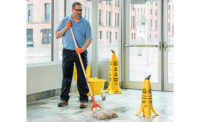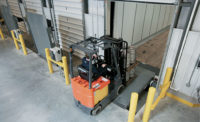Workers are often in danger of being hit by falling objects that are stored incorrectly. Injuries can also arise by improper bending and reaching to retrieve a product. Without implementing ergonomic practices, the handling of boxes, pallets, cartons and other items can cause strain and injury to different parts of the body, especially the back.
Warehouse hazards are often the cause of workplace accidents. In distribution centers, large quantities of products are stored in a variety of storage mediums. These storage mediums are selected based on throughput, dimensions and weight. Choosing the correct type of storage will greatly reduce the potential hazard in a facility. The correct storage medium will reduce improper lifting, reaching and travel distance to retrieve an item.
In a recent update from the Bureau of Labor Statistics1, there were over 880,000 occupational injuries and illnesses that resulted in multiple days away from work in a single year.
The following is a list of top injuries in a warehouse and how to avoid them.
Lifting and handling materials
Improper handling of boxes, cartons, and pallets can cause strain and injury to the body, most commonly the lower back. It is common practice to apply sound ergonomic standards for all manual material handling. When lifting an object, associates need to keep in mind the “power zone.” The power zone for lifting is close to the body, between the mid-thigh and mid-chest. This allows the back and the arms to be in the strongest position.
Overexertion injuries
These types of injuries occur when workers lift items that are big and heavy for long periods of time, resulting in excessive physical effort. In these cases, injuries can occur to joints and ligaments. In a busy warehouse, the trip length between picks can be quite long, especially if the warehouse is not organized properly. Properly planned pick paths, SKU rationalization, and appropriate slotting of SKUs can help to cut down the length the worker must travel to fill orders.
According to the National Safety Council2, overexertion causes 35 percent of all work-related injuries and contributes the most to workers’ compensation costs. To minimize overexertion, workers need to optimize the pick path when locating a product and stay within the power zone. To retrieve a heavy item, they may require ergonomic assist products such as carton flow, material handling carts, tuggers, or fork lifts.
Falling objects
Items not stored properly can fall and injure someone. If the storage racks are improperly loaded or improperly placed, the items can fall onto the floor causing injury.
Forklifts
Forklifts can overturn or they can be overloaded, subjecting materials to falling off. Accidents between forklifts or between a forklift and another surface can cause serious injury. Statistics3 show that 1 in 10 forklifts are involved in an accident each year. Managers must insure that all operators are up to date in fork truck training. Operators need to check that all routine maintenance is up to date before operating a fork lift.
Slips, trips, and falls
Each year, more than 8 million Americans will be treated in emergency rooms due to an accidental fall. If items are stored haphazardly within the distribution center, such as sticking out too far from a shelf, or placed in the middle of an aisle, workers can easily injure themselves by tripping over or running into these items. Making sure floors are dry and slip resistant is one way to prevent slips, trips, and falls.
Additional risks are possible when employees reach into racks while picking on a man-on-board order picker. Warehouses that use man-on-board picking require workers to retrieve picks at great heights. In these scenarios, pickers can be overexerting by bending and reaching into racks while towering 20+ feet off the ground.
Reducing injuries
Lifting items safely in the warehouse can help alleviate strains to the back. Transporting loads safely is another key aspect of material handling safety in a warehouse. How a worker moves, carries, or puts down a load is as important as how it is picked up. If a load is too big that the employee carrying it cannot see around it or properly grasp it, then the worker should seek help with carrying and lifting the load. Alternatively, the employee can use a forklift or other material handling equipment to carry or lift the load.
There are many best practices employees and managers alike can benefit from using in order to ensure safety in the warehouse. Implementing ergonomic best practices and equipment, as well as reducing travel time for workers and optimizing space utilization, will allow even the busiest warehouse operations to create an efficient and safe work environment for all team members.
References:
- https://www.bls.gov/news.release/pdf/osh.pdf
- https://www.nsc.org/work-safety/safety-topics/ergonomics-overexertion
- https://www.optimumsafetymanagement.com/blog/forklift-safety-infographic/



